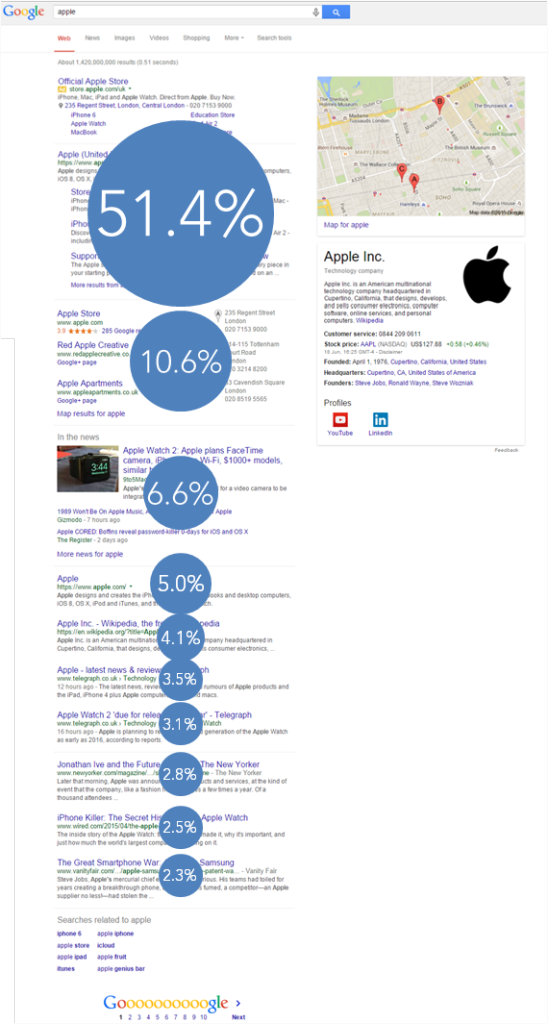‘Search intelligence’ is becoming an increasingly popular phrase within the SEO industry. It refers to the realisation that we should be using the ‘big data’ readily available to us in search to make our business decisions. For example, by analysing the words displayed in the Google search engine results pages (SERPs) we are able to gain a better understanding of demand, behaviour and the marketplace in general. Through these findings we are able to then gain a deeper understanding into brand engagement levels and therefore adapt marketing activity accordingly.
In order to put this into context I want to reflect on traditional advertising and its evolution. Advertising was built on the need to shape people’s thoughts and feelings of a brand. Millions of billboards, newspapers and commercials were all born out of this idea and have been responsible for shaping the industry into what it is today. But what tools and data were available to help advertisers measure engagement and brand sentiment in the past? Post campaign surveys and sales figures were all advertisers had to depend on which provided very little detail. But with the changing face of advertising and the increasing influence of search marketing the way campaigns are measured has completely shifted, and the need for so called ‘search intelligence’ has never been so important.
Think of the landscape of modern search. In comparison to traditional advertising the level of insights available is phenomenal. From any brand you can get a wealth of information from the SERPs which include everything from the brand website, Wikipedia information, news articles and retailers selling the brand’s products to information about their competitors and User Generated Content (USG), such as reviews on the brand and their products or services. All this information can help provide a much more in depth and detailed picture of brand engagement and sentiment, helping to understand how your brand is perceived in the public domain.
So what exactly is ‘Search Intelligence’ and how is it going to change how we measure and analyse brand engagement online?
To answer this it’s important to firstly understand how the user is engaging with the SERP. Recently at iProspect we conducted a Click Through Rate (CTR) study that covered 250,000 keywords across 120 brands, this internal research allowed has to develop a bespoke modelling for traffic estimations. What we discovered was that position one for branded terms tended to get 51.4% of all clicks, as illustrated Apple in the SERP would get 51.4% of all traffic.
Illustration of page one SERP with calculated CTRs for the search term ‘Apple’:

Therefore, from this research we were able to determine that 48.6% of all brand search terms do not always go directly to the advertisers site. The users are still engaging with the brand online but not with the owned assets that the advertiser creates and controls, but rather other assets presented to them in the SERPs, such as news articles, reviews, other retailers selling their products or event competitors.
To expand upon this example in the image above, the Telegraph article that is 6th in the organic position would get 3.5% of all the branded searches. This would amount to 35,000 visits per month for branded Apple traffic to the Telegraph site after people searched the term ‘Apple’. The searcher would then be faced with the content the Telegraph has on Apple and it’s positive or negative sentiment. It could therefore have a considerable impact on brand impression and engagement online, despite having not been produced by the brand itself.
So what do these insights mean for brand management? Understanding who is engaging with your branded traffic outside of your owned assets is vital to help build upon your brand presence and SEO ranking. At this moment in time all SEO ranking tools currently just focus on a brand’s domain when reporting the SEO position, which could potentially be giving an incomprehensive understanding of your brand online.
However, with access to the right sort of data it is possible to gain a deeper understanding of who the key operators are in the branded space from a paid (PPC & Affiliate) and organic perspective. These insights can then be applied to inform online marketing activities, such as online PR, relationship & retailer management. By digesting the wealth of branded information available online and breaking this into the key areas of Bought, Owned and Earned opportunities this will enable marketers to prioritise their efforts to achieve the maximum online visibility for brands and in turn increase brand sentiment and engagement by addressing areas of concern.
So next time you want to understand your brand and how your products are perceived amongst the online community have a look at the SERPs and think beyond just your own brand assets.





